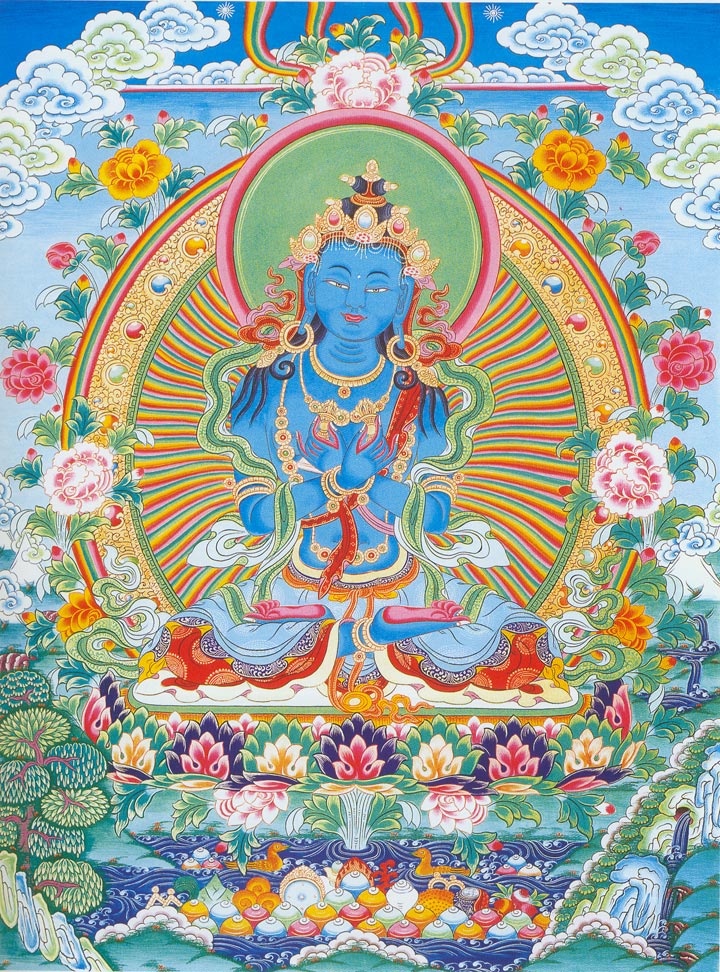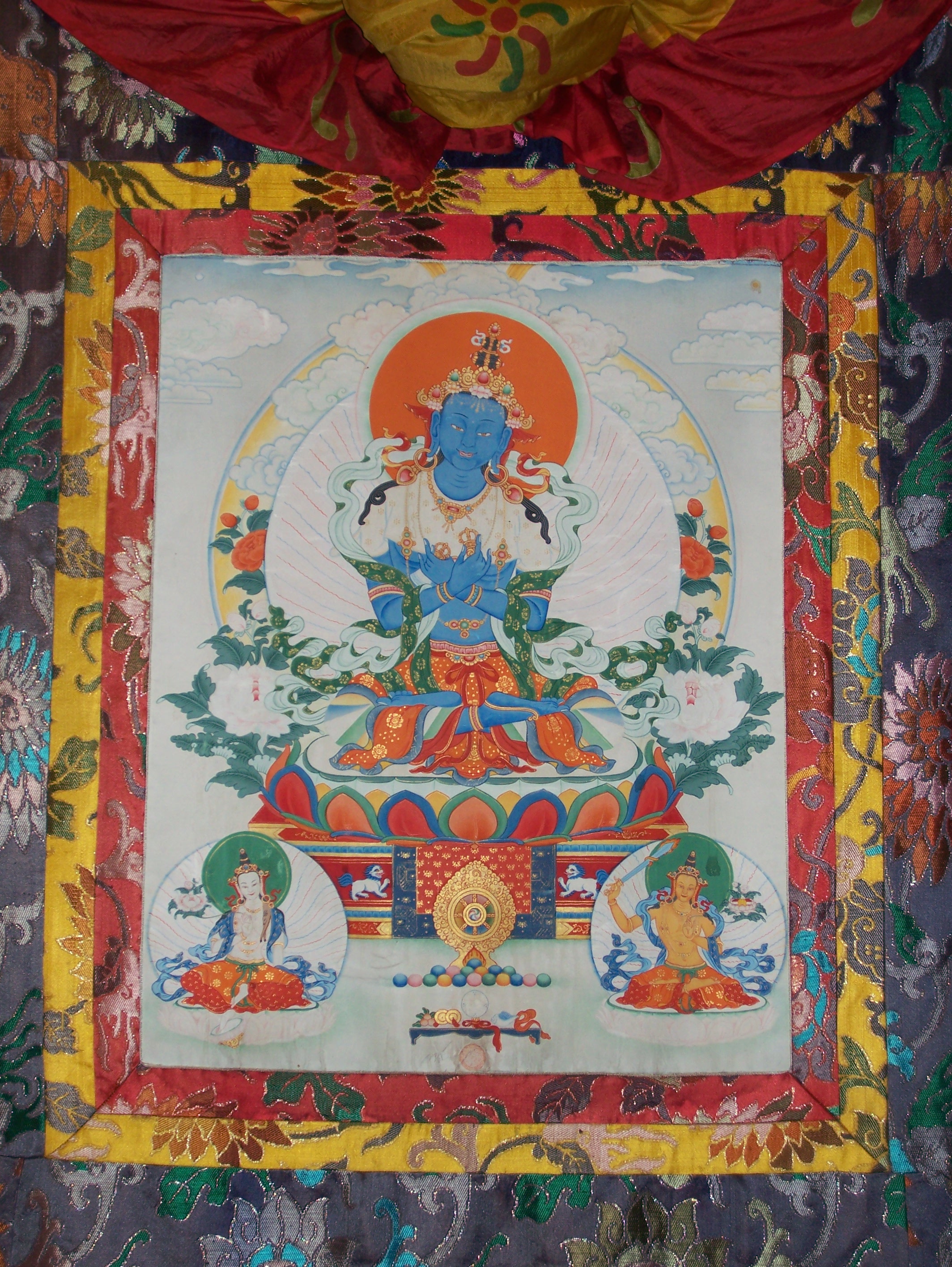|
Akaniṣṭha
In classical Buddhist Cosmology, ''Akaniṣṭha'' (Pali: ''Akaniṭṭha,'' meaning "Nothing Higher", "Unsurpassed") is the highest of the Pure Abodes, and thus the highest of all the form realms. It is the realm where devas like Maheśvara live. In Mahayana Buddhism, Akaniṣṭha is also a name for the Pure Land (Buddhafield) of the Buddha Vairocana. Tibetan Buddhism, Akaniṣṭha (Tib. '''og min)'' often describes three Akaniṣṭhas: # The Ultimate Akaniṣṭha, the formless state of dharmakaya, the dharmadhatu. # The Densely Arrayed Akaniṣṭha (Tib. '''Og min rgyan stug po bkod pa''; Skt. ''Ghanavyūhakaniṣṭha''), or the "Symbolic Akaniṣṭha" which is the realm of sambhogakaya. "Ghanavyūha Akaniṣṭha", refers to the pure Saṃbhogakāya Buddha field out of which emanate all Nirmāṇakāya Buddhas and Buddhafields such as Sukhāvati. It is the supreme Buddhafield in which all Buddhas attain Buddhahood. The Saṃbhogakāya Buddha Vajradhara is said to hav ... [...More Info...] [...Related Items...] OR: [Wikipedia] [Google] [Baidu] |
Buddhist Cosmology
Buddhist cosmology describes the planes and realms in which beings can be reborn. The spatial cosmology consists of a vertical cosmology, the various planes of beings, into which beings are reborn due to their merits and development; and a horizontal cosmology, the distribution of these world-systems into an "apparently" infinite sheet of "worlds." The temporal cosmology describes the timespan of the creation and dissolvement of universes in aeons. Buddhist cosmology is also intwined with the belief of karma, and explains that the world around us is the product of past actions. As a result, some ages are filled with prosperity and peace due to common goodness, whereas other eras are filled with suffering, dishonesty and short lifespans. Meaning and origin Course of rebirth and liberation The Buddhist cosmology is not a literal description of the shape of the universe; rather, it is the universe as seen through the (Pāli: dibbacakkhu दिब्बचक्खु), the "div ... [...More Info...] [...Related Items...] OR: [Wikipedia] [Google] [Baidu] |
Pure Abodes
The Śuddhāvāsa (Pāli: ; Tib: ) worlds, or "Pure Abodes", are distinct from the other worlds of the ' in that they do not house beings who have been born there through ordinary merit or meditative attainments, but only those Anāgāmins ("Non-returners") who are already on the path to Arhat-hood and who will attain enlightenment directly from the Śuddhāvāsa worlds without being reborn in a lower plane. Every Śuddhāvāsa deva is therefore a protector of Buddhism. (Brahma Sahampati, who appealed to the newly enlightened Buddha to teach, was an Anagami from a previous Buddha). Because a Śuddhāvāsa deva will never be reborn outside the Śuddhāvāsa worlds, no Bodhisattva is ever born in these worlds, as a Bodhisattva must ultimately be reborn as a human being. Since these devas rise from lower planes only due to the teaching of a Buddha, they can remain empty for very long periods if no Buddha arises. However, unlike the lower worlds, the Śuddhāvāsa worlds are never d ... [...More Info...] [...Related Items...] OR: [Wikipedia] [Google] [Baidu] |
Pure Land
A pure land is the celestial realm of a buddha or bodhisattva in Mahayana Buddhism. The term "pure land" is particular to East Asian Buddhism () and related traditions; in Sanskrit the equivalent concept is called a buddha-field (Sanskrit ). The various traditions that focus on pure lands have been given the nomenclature Pure Land Buddhism. Pure lands are also evident in the literature and traditions of Taoism and Bon. Discussion In the Mahayana sutras, there are many pure lands. Bodhisattvas such as Avalokiteśvara and Manjushri would obtain pure lands after they attained buddhahood. In the ''Lotus Sutra'', Buddha's close followers such as Śāriputra, Mahākāśyapa, Subhuti, Maudgalyāyana and Buddha's son Rāhula would also have pure lands. The relative time-flow in the pure lands may be different, with a day in one pure land being equivalent to years in another. Pure lands have been documented as arising due to the intention and aspiration of a bodhisattva such as the c ... [...More Info...] [...Related Items...] OR: [Wikipedia] [Google] [Baidu] |
Deva (Buddhism)
A Deva (देव Sanskrit and Pāli; Mongolian тэнгэр, tenger) in Buddhism is a type of celestial beings or gods who share the god-like characteristics of being more powerful, longer-lived, and, in general, much happier than humans, although the same level of veneration is not paid to them as to Buddhas. Other words used in Buddhist texts to refer to similar supernatural beings are devatā ("deities") and devaputta ("son of god"). While the former is a synonym for deva ("celestials"), the latter refers specifically to one of these beings who is young and has newly arisen in its heavenly world. Types Deva refers to a class of beings or a path of the six paths of the incarnation cycle. It includes some very different types of beings which can be ranked hierarchically according to the merits they have accumulated over lifetimes. The lowest classes of these beings are closer in their nature to human beings than to the higher classes of deva. Devas can be degraded to h ... [...More Info...] [...Related Items...] OR: [Wikipedia] [Google] [Baidu] |
Nirmāṇakāya
Nirmāṇakāya (Sanskrit; zh, t=應身, p=yīngshēn; Tib. སྤྲུལ་སྐུ་, ''tulku'', Wyl. ''sprul sku'') is the third aspect of the trikāya and the physical manifestation of a Buddha in time and space. In Vajrayāna it is described as "the dimension of ceaseless manifestation." Indian Buddhism One early Buddhist text, the Pali ''Samaññaphala Sutta'', lists the ability to create a “mind-made body” (''manomāyakāya'') as one of the "fruits of the contemplative life". Commentarial texts such as the '' Patisambhidamagga'' and the ''Visuddhimagga'' state that this mind-made body is how Gautama Buddha and arhats are able to travel into heavenly realms using the continuum of the mindstream (''cittasaṃtāna'') and it is also used to explain the multiplication miracle of the Buddha as illustrated in the ''Divyavadana'', in which the Buddha multiplied his ''nirmita'' or emanated human form into countless other bodies which filled the sky. A Buddha or other reali ... [...More Info...] [...Related Items...] OR: [Wikipedia] [Google] [Baidu] |
Saṃbhogakāya
''Saṃbhogakāya'' ( sa, संभोगकाय lit. "body of enjoyment", zh, t=報身, p=bàoshēn, Tib: ''longs spyod rdzog pa'i sku'') is the second mode or aspect of the Trikaya. Definition Celestial manifestations ''Sambhogakāya'' is a "subtle body of limitless form". Buddhas such as Bhaisajyaguru and Amitābha, as well as advanced bodhisattvas such as Avalokiteśvara and Manjusri can appear in an "enjoyment-body." A Buddha can appear in an "enjoyment-body" to teach bodhisattvas through visionary experiences. Those Buddhas and Bodhisattvas manifest themselves in their specific pure lands. These worlds are created for the benefits of others. In those lands it is easy to hear and practice the Dharma. A person can be reborn in such a pure land by "the transfer of some of the huge stock of 'merit' of a Land's presiding Buddha, stimulated by devout prayer." One of the places where the ''Sambhogakāya'' appears is the extra-cosmic realm or pure land called Akaniṣṭha. ... [...More Info...] [...Related Items...] OR: [Wikipedia] [Google] [Baidu] |
Dharmakāya
The ''dharmakāya'' ( sa, धर्म काय, "truth body" or "reality body", zh, t=法身, p=fǎshēn, ) is one of the three bodies (''trikāya'') of a buddha in Mahāyāna Buddhism. The ''dharmakāya'' constitutes the unmanifested, "inconceivable" (''acintya'') aspect of a buddha out of which buddhas arise and to which they return after their dissolution. Buddhas are manifestations of the ''dharmakāya'' called the ''nirmāṇakāya'', "transformation body". The Dhammakāya tradition of Thailand and the ''Tathāgatagarbha sūtras'' of the ancient Indian tradition view the ''dharmakāya'' as the '' ātman'' (true self) of the Buddha present within all beings. Origins and development Pali Canon In the Pāli Canon, Gautama Buddha tells Vasettha that the Tathāgata (the Buddha) is ''dhammakaya'', the "truth-body" or the "embodiment of truth", as well as ''dharmabhuta'', "truth-become", that is, "one who has become truth." During the Buddha's life great veneration was ... [...More Info...] [...Related Items...] OR: [Wikipedia] [Google] [Baidu] |
Vajradhara
Vajradhara (Sanskrit: वज्रधर. (Also, the name of Indra, because 'Vajra' means diamond, as well as the thunderbolt, anything hard more generally) Tibetan: རྡོ་རྗེ་འཆང། rdo rje 'chang (Dorje Chang); zh, t=金剛總持, p=Jīngāng zǒng chí; Javanese: Kabajradharan; Japanese: 持金剛仏; English: Diamond-holder; Vietnamese: Kim Cang Tổng Trì) is the ultimate primordial Buddha, or Adi-Buddha, according to the Sakya, Gelug and Kagyu schools of Tibetan Buddhism. In the evolution of Indian Buddhism, Buddha Vajradhara gradually displaced Samantabhadra, who is the 'Primordial Buddha' in the Nyingma, or 'Ancient School.' However, the two are metaphysically equivalent. Achieving the 'state of Vajradhara' is synonymous with complete realisation. According to the Kagyu lineage, Buddhā Vajradhara is the primordial Buddha, the Dharmakaya Buddha. He is depicted as dark blue in color, expressing the quintessence of buddhahood itself and representing ... [...More Info...] [...Related Items...] OR: [Wikipedia] [Google] [Baidu] |
Sukhavati
Sukhavati (IAST: ''Sukhāvatī''; "Blissful") is a pure land of Amitābha in Mahayana Buddhism. It is also called the Land of Bliss or Western Pure Land, and is the most well-known of Buddhist pure lands, due to the popularity of Pure Land Buddhism in East Asia. Etymology and names The word is the feminine form of ''sukhāvat'' ("full of joy; blissful"), from ''sukha'' ("delight, joy") and ''-vat'' ("full of"). Sukhavati is known by different names in other languages. East Asian names are based on Chinese translations, and longer names may consist of the words "Western", "Blissful" and "Pure Land" in various combinations. Some names and combinations are more popular in certain countries. Due to its importance, Sukhavati is often simply called "The Pure Land" without distinguishing it from other pure lands. * Only common in Chinese. Nine levels of birth In the final part of the ''Amitāyurdhyāna Sūtra'', Gautama Buddha discusses the nine levels into which those born into ... [...More Info...] [...Related Items...] OR: [Wikipedia] [Google] [Baidu] |
Dharmadhatu
Dharmadhatu (Sanskrit) is the 'dimension', 'realm' or 'sphere' (dhātu) of the Dharma or Absolute Reality. Definition In Mahayana Buddhism, dharmadhātu ( bo, chos kyi dbyings; ) means "realm of phenomena", "realm of truth", and of the noumenon. It is referred to by several analogous terms from Mahayana Buddhist philosophy, such as Tathata (Reality "as-it-is"), emptiness, dependent co-arising and eternal Buddha. It is the "deepest nature, or essence". Dharmadhātu is the purified mind in its natural state, free of obscurations. It is the essence-quality or nature of mind, the fundamental ground of consciousness of the trikaya, which is accessed via the mindstream. When the buddha-nature has been realised, dharmadhātu is also referred to as the Dharmakāya, the ''Body of Dharma Truth''. It is associated with Vairocana. Historical origin Kang-nam Oh traces the origin of dharmadhatu to the Avatamsaka Sutra. It has been further developed by the Hua-yen school: Understa ... [...More Info...] [...Related Items...] OR: [Wikipedia] [Google] [Baidu] |
Tibetan Buddhism
Tibetan Buddhism (also referred to as Indo-Tibetan Buddhism, Lamaism, Lamaistic Buddhism, Himalayan Buddhism, and Northern Buddhism) is the form of Buddhism practiced in Tibet and Bhutan, where it is the dominant religion. It is also in majority regions surrounding the Himalayan areas of India (such as Ladakh, Sikkim, Arunachal Pradesh, and a minority in Himachal Pradesh and Uttarakhand), in much of Central Asia, in the southern Siberian regions such as Tuva, and in Mongolia. Tibetan Buddhism evolved as a form of Mahāyāna Buddhism stemming from the latest stages of Indian Buddhism (which also included many Vajrayāna elements). It thus preserves many Indian Buddhist tantric practices of the post-Gupta early medieval period (500 to 1200 CE), along with numerous native Tibetan developments. In the pre-modern era, Tibetan Buddhism spread outside of Tibet primarily due to the influence of the Mongol Yuan dynasty (1271–1368), founded by Kublai Khan, which had ruled China, ... [...More Info...] [...Related Items...] OR: [Wikipedia] [Google] [Baidu] |


.jpg)


.jpeg/1200px-Tibetan_Buddhism_(214837929).jpeg)